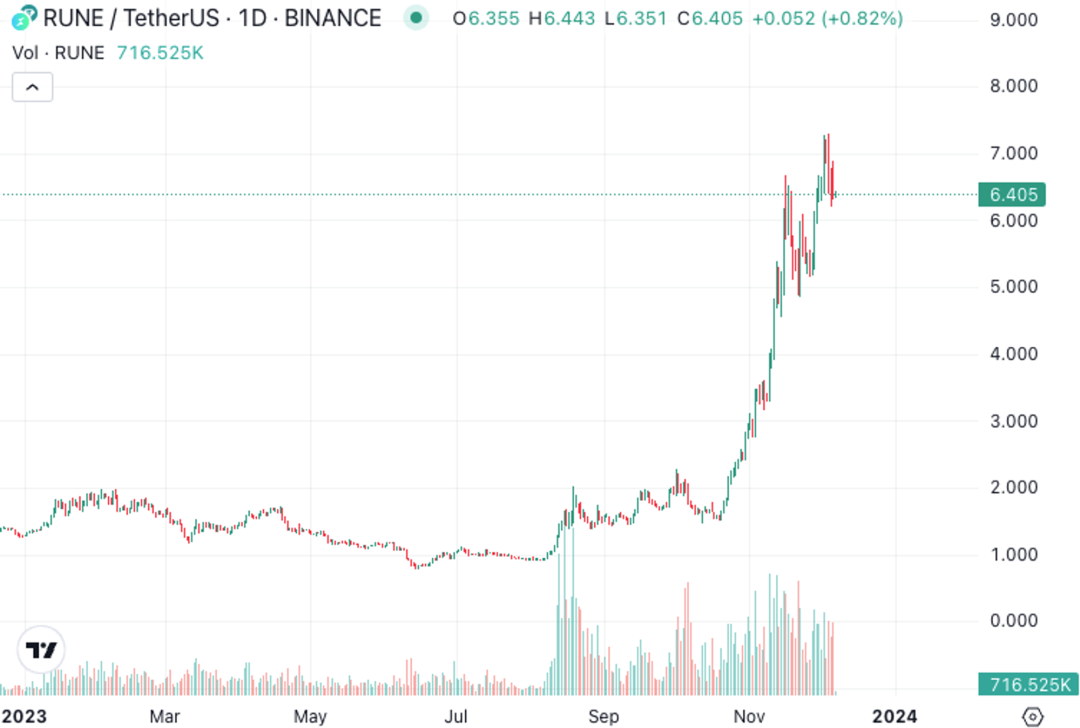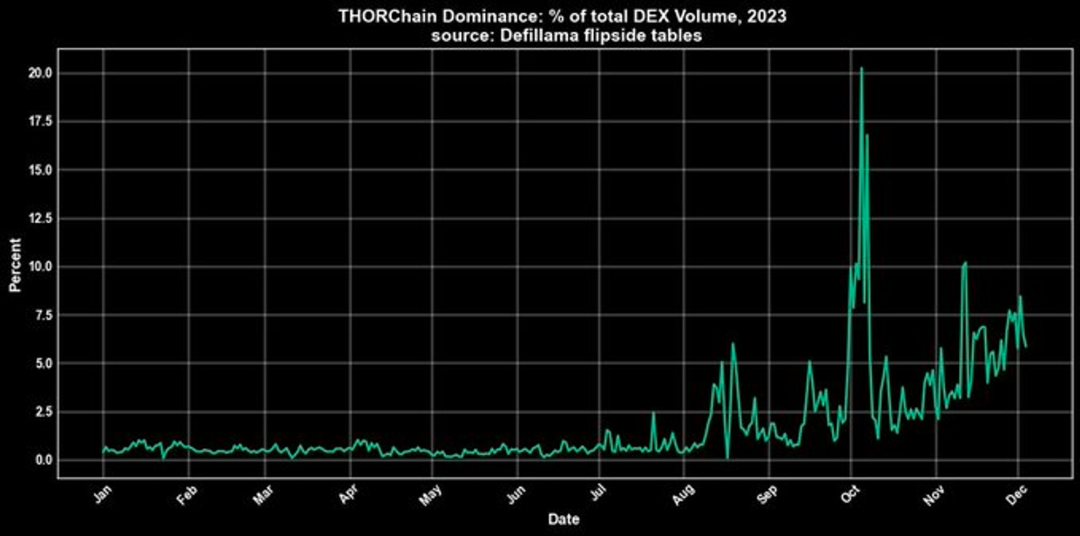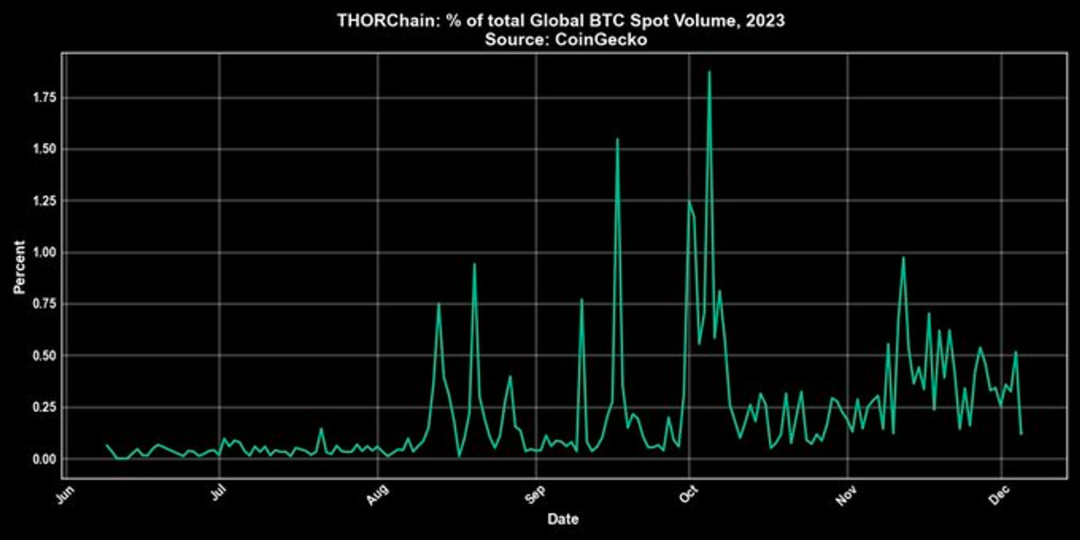Production: DODOResearch
Author: dt X Gryphsis Academy
Editor: Lisa
Compared to the thriving development of the BTC ecosystem and the sudden surge in the AI track, Ethereum's Defi projects seem to be lackluster in this round of market gains, but there is one product that has been quietly gaining momentum, rising more than four times in the last quarter of 2023, and more than six times from the annual low point. Continuously delivering products and updates in the bear market, that is the most eye-catching Defi project in the market right now - the cross-chain DEX protocol Thorchain.
This week, Dr.DODO, in collaboration with Gryphsis Academy, will introduce you to this veteran Defi protocol Thorchain, and discuss what it is and what updates it has made, as well as introduce you to other projects in the cross-chain DEX track besides Thorchain that are worth paying attention to.

What is Thorchain?
Thorchain can be said to be one of the oldest DeFi projects on the chain, with the team established as early as 2018 and the product launched in 2019. Despite experiencing multiple hacking incidents, with the strong support of its team and the unwavering community, Thorchain continues to deliver and has become one of the top fifty blue-chip projects in terms of market value.
Thorchain's main business is a decentralized cross-chain AMM, allowing users to exchange and trade between different blockchain assets without the need to trust third-party institutions. Unlike centralized exchanges, Thorchain operates based on a specially designed trustless protocol, allowing users to exchange cross-chain assets without frictional losses by depositing trading funds into liquidity pools. Unlike cross-chain bridges, Thorchain provides native asset cross-chain rather than wrapped token form. Thorchain uses the Cosmos SDK to build a blockchain and creates multiple native token (BTC, ETH) and Thorchain token $RUNE AMM pools within its protocol. When users cross-chain, they actually swap through Rune for native assets on different blockchains.
Technically, Thorchain uses advanced cross-chain messaging systems and a customized Byzantine fault-tolerant algorithm. After being attacked by hackers multiple times, it has been continuously improved to enhance the security of cross-chain messaging. Thorchain is considered one of the most promising cross-chain infrastructures, solving the pain points of cross-chain asset liquidity and trading efficiency, and has become the best route for cross-chain BTC-ETH liquidity on the chain.
What updates has Thorchain made?
Thorchain has welcomed two major updates this year. The first is the introduction of the Streaming Swaps mechanism, allowing users to instantly conduct large-scale cross-chain asset exchanges, overcoming the previous problem of poor liquidity leading to low user participation. Here are the main ideas for users to use Streaming Swap:
- Users initiate a large-scale cross-chain exchange, such as exchanging 10 BTC for 3000 ETH.
- The protocol splits this exchange into multiple small Streaming Swaps, each with a unit of 0.1 BTC.
- After each 0.1 BTC is exchanged for approximately 30 ETH in a streaming exchange, the ETH is immediately sent to the user.
- Repeat the streaming exchange until all 10 BTC are exchanged for 3000 ETH.
This streaming exchange mechanism achieves instant settlement of large exchanges, reduces slippage losses, improves capital utilization efficiency, and also enhances the protocol's resistance to front-running attacks.
From a data perspective, since the launch of Streaming Swap in the third quarter of this year, trading data has shown significant growth, with the main trading volume still being on the BTC trading pairs. This shows that Thorchain has been successful in providing a more efficient and convenient cross-chain trading solution, attracting more users to participate.

Thorchain's market share of all DEX trading volume Source: Defillama

Thorchain's market share of all BTC trading Source: Coingecko
Another major update is the official launch of Thorchain Lending, which has been discussed on the forum for nearly two years. Thorchain Lending features interest-free, non-forced liquidation, and no maturity date lending products, meeting users' borrowing and leverage needs. So, how is interest-free, non-forced liquidation, and no maturity date achieved?
The main reasons include:
- Interest comes from the income of pledged assets, rather than being paid by the borrower, thus achieving interest-free lending.
- The additional collateral asset ratio is as high as 150%-250%, reducing liquidation risk; liquidation decisions are entirely based on smart contracts and protocol rules, without human intervention.
- Borrowers only need to continuously replenish collateral assets to use the borrowed funds for the long term, thus there is no pressure of maturity date, and the borrowing period is only constrained by the duration of the collateral.
- Borrowers pledge ETH to obtain stablecoin loans, and ETH generates income through liquidity mining, which can offset borrowing costs and generate net income.
- Liquidation comes from the transfer of collateral asset premiums, without the need for borrowers to actively bear the risk, and the risk can be controlled.
The launch of Thorchain Saver Vault, along with Lending, has further increased Thorchain's total locked value (TVL). Saver Vault allows DeFi users to deposit native tokens without bearing the fluctuation risk of $Rune, effectively attracting users to deposit assets and providing a source of basic assets for long-term collateral. These innovative measures provide users with more choices and convenience, and are expected to promote the growth and development of the Thorchain ecosystem.
Competitor in the same track - Maya
Maya Protocol is a decentralized cross-chain protocol built on top of Thorchain, launched in March this year, and is a friendly fork project of Thorchain, supported by the Thorchain community. It differs significantly from Thorchain in the cross-chain AMM mechanism, with the following main differences:
- As a friendly fork of Thorchain, Maya Protocol's goal is not to replace but to enhance Thorchain, providing backup support and flexibility for decentralized infrastructure, similar to how dual engines on an airplane can improve reliability.
- Maya introduces some unique designs for capital efficiency, security, and value acquisition, such as liquidity nodes, dual token mechanism, impermanent loss protection, etc.
- Maya also plans to support more public chains such as Arbitrum, Cardano, and smart contract chain Aztec to help expand the entire cross-chain ecosystem.
- Through collaboration, they have also achieved some functional integration, such as one-click cross-platform aggregated trading, streaming exchange, etc., allowing users to seamlessly operate between the two platforms.
Overall, Maya and Thorchain have built a complementary cross-chain alliance, solving the limitations of a single solution and jointly promoting the development of decentralized finance.
Competitor in the same track - ChainFlip
Different from Maya Protocol, which is a community-based fork project, Chainflip has a significant background as one of the top-tier projects with tens of millions in funding. It was led by Framework Ventures and participated by Blockchain Capital and Pantera Capital in 2021 and 2022, raising a total of $16 million. Finally, it has launched its mainnet this year, but its product has not yet been opened for use.
Chainflip is a hybrid decentralized trading protocol that allows seamless value transfer between any blockchain (including BTC, EVM, and underlying networks). It aims to combine the advantages of centralized exchanges and DEX to achieve efficient asset trading and risk management.
Its biggest selling point is the Jit AMM mechanism design, which aims to solve cross-chain challenges by minimizing slippage and providing precise pricing. This addresses the drawback in Thorchain where liquidity providers have to bear significant losses, allowing market makers to join single-sided liquidity. Additionally, it has improved the user-friendly experience, addressing the need for specific wallet installation in Thorchain. Chainflip supports users to convert values on any chain using a regular wallet.
Overall, Chainflip claims to have a better product experience and design compared to Thorchain. However, although its mainnet has been launched, the flagship product, the cross-chain DEX, has not been opened for use. Whether it can effectively attract TVL and whether the product can survive in the long term are key factors for its future, especially considering that Thorchain has been deeply involved in this track for many years and would require considerable effort to compete for market share.
Author's Opinion
Scott@GryphsisAcademy
I analyze and discuss from a trading perspective. We initially added $RUNE to the watchlist because of the explosive growth of Bitcoin in May. At that time, we conducted a review of the Bitcoin ecosystem, and ThorChain, as a native cross-chain DEX for Bitcoin, was included. Additionally, ThorChain is built on the COSMOS SDK, and the recent explosive growth of the COSMOS ecosystem, including TIA, INJ, and KUJI, has attracted attention to the speculation in the COSMOS ecosystem. Therefore, ThorChain can capture both the Bitcoin ecosystem and the COSMOS ecosystem.
Furthermore, ThorChain's strong value capture capability in its economic model, first-mover advantage, and the team's active innovation during the bear market, such as the introduction of Streaming Swaps and "Ponzi" lending in July and August, sparked discussions and attention in the market, laying the groundwork for the growth of TVL and Volume in the bull market. Therefore, it has demonstrated strong Alpha capabilities in the Bitcoin and COSMOS ecosystem tracks.
The later emergence of Maya Protocol and ChainFlip as competitors to ThorChain has also provided a valuation anchor. At that time, many on Twitter were conducting comparable valuation analyses of price multipliers, leading to the conclusion that they should go for $CACAO and $FLIP. When more and more new competitive projects emerge in the market, new projects can break the barriers of old projects by offering higher token incentives, which is an interesting aspect of Web3 tokenomics. At the same time, the emergence of more competitors will divert investors' attention. Therefore, currently, we will consider appropriate reductions based on some funding indicators.
@19971122 DT
In my opinion, with the current trend of the thriving BTC ecosystem, the demand for cross-chain transactions between ETH and other EVM public chains, as well as the recently popular Solana ecosystem, will become increasingly strong. Cross-chain DEX is indeed a growing business in this wave. However, the recent surge in Rune is more inclined towards the launch of Thorchain Lending, which brings more use cases for Rune and effectively causes a flywheel effect through token burn. It is not purely the demand for growth in the cross-chain DEX business that has led to such an increase. In the current market sentiment, it is quite normal for similar concept tokens to rotate in the short term. In the long run, I will focus more on Thorchain itself because I believe that a large part of Thorchain's success is not due to its outstanding product, but rather the strong connection between the project team and the community. Many educational materials about Thorchain are community-driven, and its perseverance after multiple hacking incidents demonstrates the determination of its project team. Therefore, in this track, Thorchain is definitely the leader and will continue to be so in the short term.
免责声明:本文章仅代表作者个人观点,不代表本平台的立场和观点。本文章仅供信息分享,不构成对任何人的任何投资建议。用户与作者之间的任何争议,与本平台无关。如网页中刊载的文章或图片涉及侵权,请提供相关的权利证明和身份证明发送邮件到support@aicoin.com,本平台相关工作人员将会进行核查。




